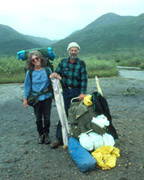Pipe Spring National Monument

Evan Cram, whose great, great Mormon uncle born in bedroom of "Winsor Castle," here explaining cheese making.
©Bert Gildart: Evan Cram is a towering young ranger of Mormon descent. As the great, great nephew of a man born in one of the bedrooms of the old ranch that now sit adjacent to the perpetual water source known as Pipe Spring National Monument, he is the perfect person to interpret the area to people such as Janie and me.
Arizona’s Pipe Spring derives its name from the perpetual water that flows from the Vermilion Cliffs. During periods of rain and snow, water seeps down to a hard shale layer, which then directs it laterally to such places as Pipe Spring. Here, water is still further directed, but now by pipes, where it continues to flow throughout the ranch and eventually to several ponds.
A “TITHING” RANCH
Over the past 12,000 years many have known of the springs. Paiute Indians used the area extensively, but the Mormons developed it, bringing Evan’s ancestors here, responding to a call from Brigham Young. As Evan explained, Young needed a “tithing ranch” to take care of the “tithing herd.” Mormons, he said were (and are) encouraged to give 10 percent of their earnings to the church — and in those days, they gave cattle to satisfy their obligation. A herd soon developed and Young realized local Mormons needed a ranch, a place such as Pipe Spring, which had a steady supply of water.
Pipe Springs’ isolation served yet another Mormon practice, that of polygamy. The spring is located along the “Arizona Strip” in a secluded area between the Grand Canyon and Zion, providing a wonderful place for polygamist husbands to hide their additional wives from Federal eyes.
L TO R: Pipe Spring showing “Winsor Castle” and two of the “ponds” used for collecting water; out building; old wagon used for work on ranch.
For awhile, all went well, but in the 1880s, polygamy came to national consciousness and Federal marshals descended on Utah to apprehend polygamists.
WATCHFUL POLYGAMISTS
Ever watchful, Pipe Spring residents erected an observation tower that commanded a sweeping view of their surroundings. If marshals appeared on the skyline, wives and children would slip out of the compound and hide themselves in the nearby cliffs.
Today, a half mile-long trail leads toward the Vermilon Cliffs, which Janie and I followed. Though there was no mention of polygamy, signs interpreted the coming of the telegraph. As well, it detailed the area’s natural history, much through the eyes of the Paiute Indians.
L TO R: Long horned cattle wander portions of the national monument; half-mile-long trail ascends to wonderful vantage points atop Vermilion Cliffs, simultaneously interpreting areas history and Native American use of plants; watch tower atop Winsor Castle, used to search surrounding sweep for federal marshalls who were intent on bringing cessation to polygamy.
Eventually, private ranchers purchased the spring, but with time – and overgrazing — the ranch soon floundered, prompting the owners to consider selling. About this time, one of my heroes, Steven Mather, first director of the National Park Service and a man who traveled widely to determine an area’s suitability for status as a national park, came to believe Pipe Spring would make a fascinating stopover for those traveling between Grand Canyon and Zion national parks.
He suggested its addition to the National Park System and on May 31, 1923, Warren Harding signed the proclamation declaring the complex a national monument.
DUAL MANAGEMENT
Because the Southern Kaibab Paiute Reservation surrounds the spring, and because of so much historic Native American usage of the area, today, Pipe Spring is cooperatively managed by the tribe and by the National Park Service. Hike the park trail and you will discover just how well this works, for both agencies provide interpretive information.
Explore a bit more and you’ll see long-horn cattle, and in season, you’ll see demonstrations on ranching, sandstone masonry, cheese making, and blacksmithing.
And tomorrow tonight, if you were there, you’d see a once a year Christmas presentation. The celebration will feature music played on an old organ, and many of the antique furnishing will be festively decorated.
Unfortunately, we’ll miss the celebration as we are trying to move north – to be back home in Montana for Christmas. At the moment we’re at a campground near just south of Pocatello, Idaho, watching a new storm drop more snow.
Seems like a replay of last spring, when we were also trying to get home.
Will be keeping family, friends and readers appraised.
—————————————————————
THIS TIME THREE YEARS AGO:
*Pero, The Luckiest Mouse Alive
ADS FROM GOOGLE AND AMAZON AUGMENT OUR TRAVELS:








